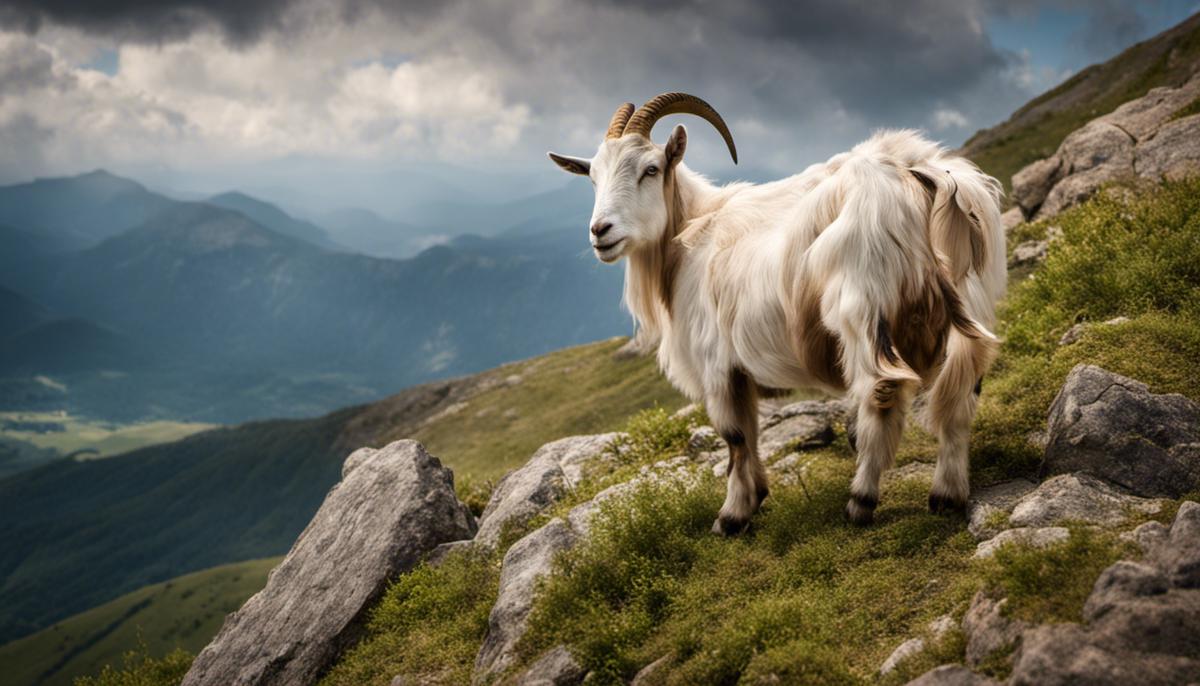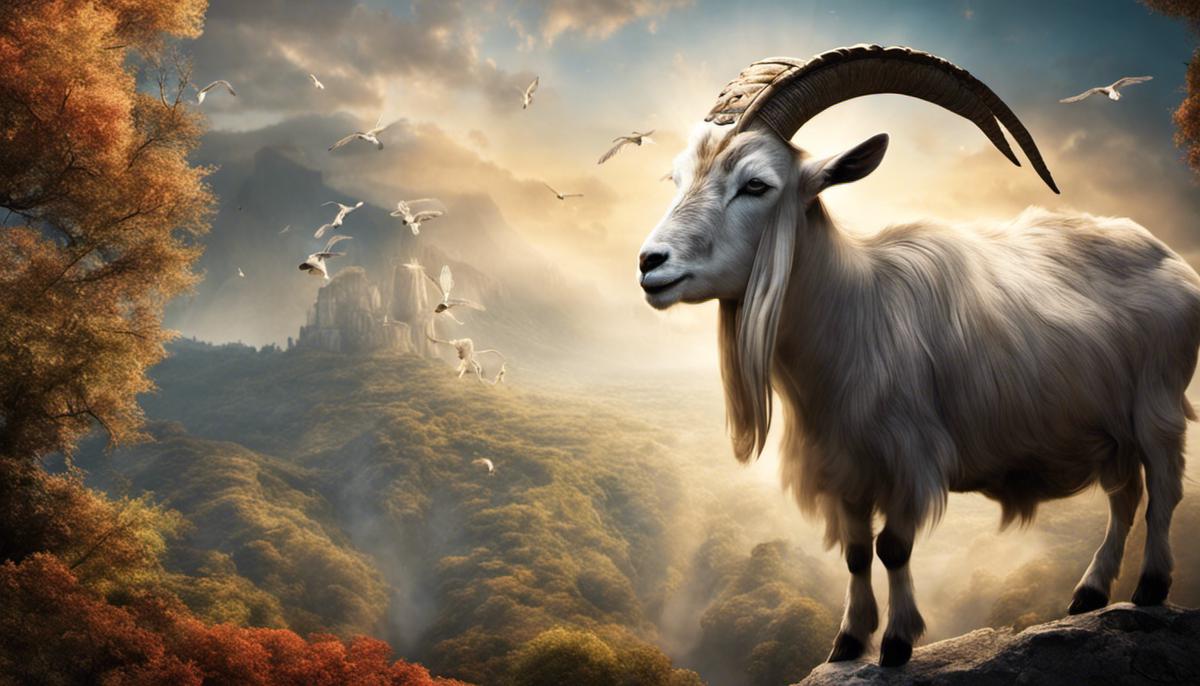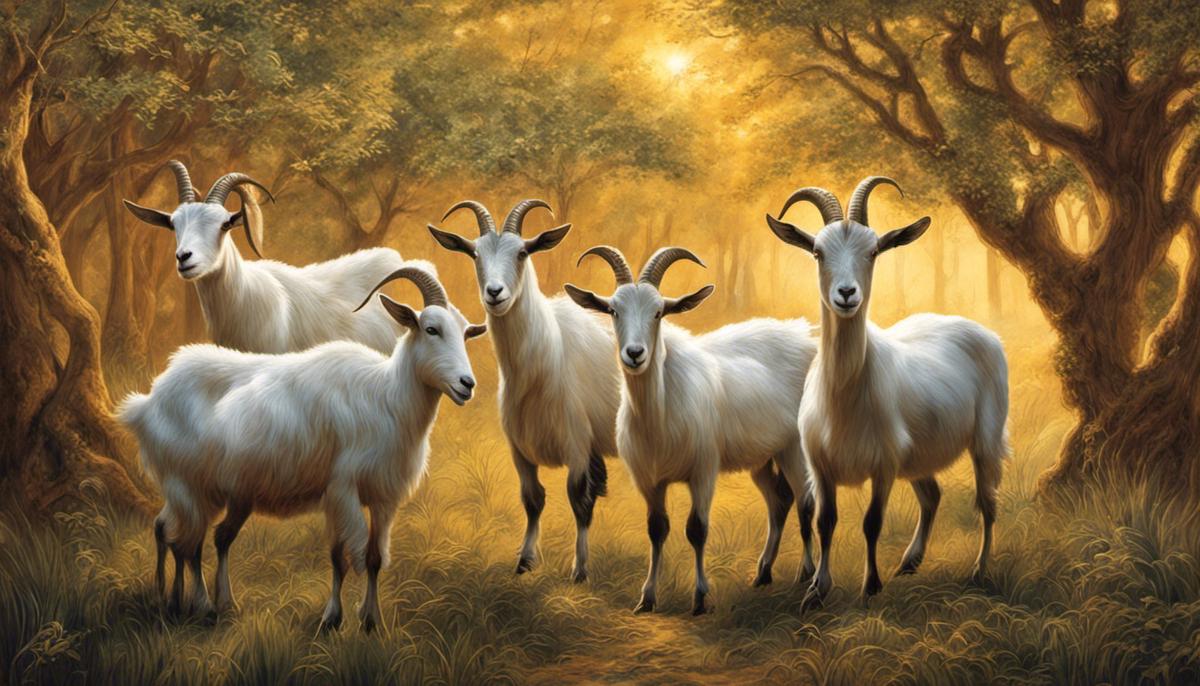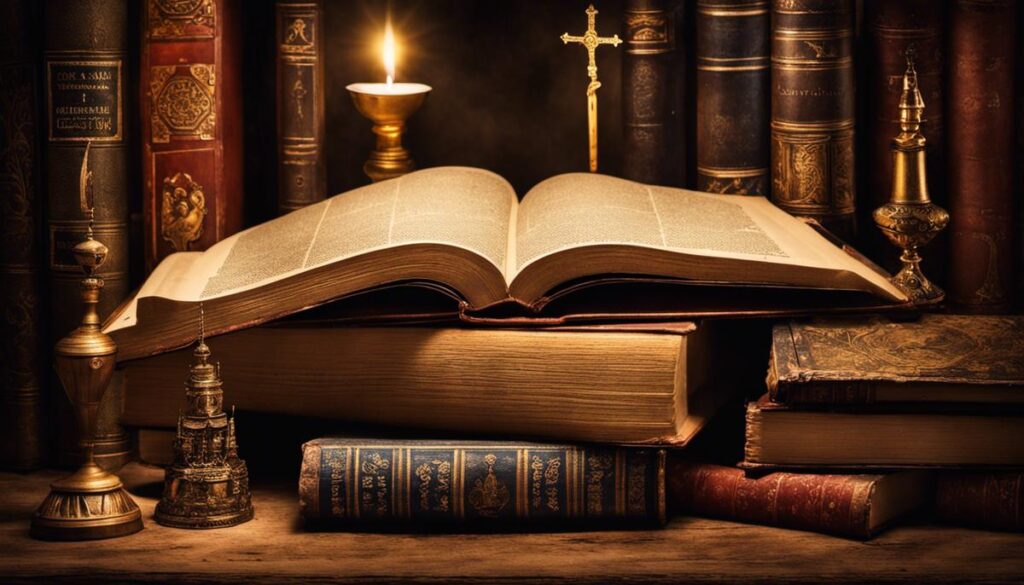In the intriguing and diverse world of biblical symbolism, animals oftentimes play pivotal roles in conveying layered meanings. Among these animals, the goat carries a unique significance in ancient cultures, marking its relevance in various societies that influenced the creation of biblical texts. The profound symbolic representation of goats extends further into the textual tapestry of the Hebrew Bible, the Old Testament, and the Christian Bible, the New Testament, which allows for a wealth of interpretations when one dreams about this creature. This study offers a glimpse into the world of ancient wisdom and belief systems, meshing it with contemporary psychoanalytical approaches to dream interpretation. The goat, an animal with multifaceted roles, serves us as a metaphorical journeyman guiding us through this complex exploration.
Symbolism of Goats in Ancient Cultures
Untangling Threads of Interpretation: Goat Symbolism in Ancient Cultures and Bible Dream Analysis
Goats, a common sight in many agrarian societies, carry complex and multivalent cultural symbolism, stretching from ancient times to the present day. A decipherment of this symbolism, specifically in the context of ancient cultures, could provide a deeper understanding and enriched interpretation of biblical dreams featuring goats.
In ancient cultures, the goat was often regarded as a symbol of life-sustaining sustenance, independence, resilience and fertility. In Egypt, the goat symbolized the god Osiris, embodying creative power and fertility, while in Greek mythology, the goat was associated with Zeus, embodying authority and strength. These associations offer a glimpse into the reverence and respect commanded by goats in ancient societies and emerge as fundamental to the interpretation of dream symbolism.
Elucidation of the symbolism of goats in biblical context requires a dive into biblical literature. In the Book of Leviticus, goats were used as sin offerings, representing expiation and forgiveness. Conversely, in the Book of Matthew, goats symbolized the damned at the Last Judgment. This dichotomy reflects that goats, like other symbols, do not carry singular, concrete meanings but are multifarious and context-dependent.
Within dream interpretation, biblical or otherwise, one finds the iconic interpretation of goats as harbingers of prosperity and abundance, reflective of their association with subsistence in agrarian societies. Equally, dreams of goats can evoke their role in sin offerings, channeling interpretations of atonement and forgiveness. The aforementioned dichotomy between the blessed and the damned further deepens the interpretative richness.
Psychoanalytically speaking, the noted psychologist Carl Jung classified goats as a symbol of the ‘shadow self’, representing personal attributes one fails to recognize. Pairing this with biblical understanding, a dream of a goat might suggest unacknowledged sins or personal shortcomings, a subconscious confession cloaked in the form of a dream.
While archeology and anthropology provide insights into ancient societies’ understanding of goat symbolism, caution is required. It is important to remember that context, both cultural and personal, significantly shapes symbolic understanding. A single symbol in a dream, such as a goat, might bear manifold interpretations depending upon the cultural background, personal experiences, and subconscious nuances of the dreamer.
Societal, cultural, and individual contexts, therefore, all play crucial roles in dream interpretation. An exploration into the symbolism of goats within these contexts, ancient and biblical, could illuminate and enrich the interpretation arena. However, it must be remembered that conclusive interpretations lie in the realm of elusive dreamscapes, as complex and multifaceted as the symbolism of the humble yet enigmatic goat.

Goats in the Hebrew Bible (Old Testament)
The depiction of goats in the Old Testament is richly multifaceted, which is reflective of the diverse religious, societal, and cultural contexts of the ancient Near East. As we delve further into the textual references to goats, it is remarkable how they subsequently imbue the interpretation of goat appearances in dreams with deeply profound significance.
The Old Testament bears witness to about 200 references to goats, profoundly elevating their symbolic status in this ancient text. The goat occupies numerous roles depending on each biblical context, distinctly acting as a conduit to light the essence of the human-divine relationship.
One predominant role of goats in the Old Testament is their utilization in sacrificial rituals, as dictated in the book of Leviticus. Goats were commonly used as sin offerings, the blood shed viewed as an atonement for the transgressions of the community. This sacrificial role aligns goats with the realm of expiation, forgiveness, and purification in dream symbolism.
In alignment with this, the practice of ‘scapegoating,’ as outlined in Leviticus 16, imbues the goat with yet another facet of significance. One goat is loaded symbolically with the sins of the Israelites and driven into the wilderness, carrying the sins away from the community. This act further solidifies the symbolic representation of the goat as a vehicle for the removal of guilt and sin, a theme commonly echoed in a dream context.
Alternatively, goats in the Old Testament also serve as metaphors for fertile abundance. The book of Deuteronomy frequently associates the goat with prosperity and blessing, highlighting their wealth and productivity in the ancient agrarian society. As such, their appearance in dreams might signify impending abundance or prosperity.
On a more cautionary note, the prophetic book of Daniel uses the symbolism of a ram and a goat to indicate powerful empires clashing, thereby shedding light on a potential interpretation of a dream goat as a signal of impending conflict and turmoil.
Another intriguing metaphorical usage is found in Matthew’s Gospel, where the Last Judgement scene portrays the division of the righteous (the sheep) and the unrighteous (the goats). Here, the goat symbolizes spiritual rebelliousness and transgression, an interpretation that naturally feeds into our understanding of goat symbolism in dreams.
As we traverse these connections between Old Testament goat symbolism and dream interpretation, it’s apparent how the nuances of these interpretations primarily hinge upon the individual’s cultural, societal, and personal contexts. The very nature of dreams and their interpretations is highly subjective and deeply embedded in the individual’s mental framework, influenced by a myriad of factors including their spiritual, emotional, psychological, and cultural contexts.
In conclusion, to decode the representation of a goat in a dream, one must intertwine the biblical undertones with the dreamer’s individual context, weaving a rich tapestry of meaning and understanding. One must remember that dream interpretation is not a solitary journey but an engaging dialogue between the conscious and the subconscious, influenced by symbolic manifestations such as the multifaceted goat of the Old Testament.

Goats in the Christian Bible (New Testament)
Continuing from the discussion on goat representation in dreams and various cultures, it is vital to narrow down on the distinctive aspect of goat symbolism in the New Testament, providing a dimensional view on this intriguing subject.
The New Testament constructs several portrayals of goats, meticulously intertwining them within the teachings of Christ and the lives of His followers.
Goats’ portrayal in the New Testament subtly straddles across metaphoric dimensions. The Gospel of Matthew (25:31-46) presents arguably the most potent representation of goats. In this scripture, the prophetic utterance of Christ places goats on His left during the final judgment, while the sheep stay on His right. This metaphorical distinction between sheep and goats gravitates towards moralistic implications. The goats symbolize individuals who, despite having been given the opportunities to perform righteous deeds, prioritized self-interests over altruism. From this biblical context, goats in a dream could reflect a subconscious prompt towards self-assessment, introspection on moral standing.
Another compelling context arises in the context of sin, redemption, and the scapegoat ritual. In stark contrast to the scapegoat’s function in Levitical law in the Old Testament, the New Testament presents Christ as the ultimate scapegoat. The Apostles’ letters stand testament to this transformation, with Christ being metaphorically assigned the role of the sacrificial goat to atone for human sin (Hebrews 10:1-18). A dream featuring a goat could transcend subconscious guilt or the anticipation of divine forgiveness if viewed from this perspective.
However, projecting goats solely as negative symbols would be a narrowed view. Goats were also seen as robust, agile creatures, capable of traversing treacherous terrain. Their resilience and adaptability become ideal symbolic props to reflect spiritual endurance and persistence in faith amidst trials (Acts 20:29). A goat’s presence in one’s dream might as well be a divine nudge towards perseverance and unyielding faith under challenging circumstances.
In examining the goats’ representation in dreams, it is noteworthy to consider the quintessential Jungian school of thought, which proposes dreams as a channel to delve into our subconscious depths. Here, the appearance of a goat may reveal unexplored, suppressed facets of oneself. Concurrently, the societal and cultural echo of biblical teachings about goats could subliminally influence the dreamer’s interpretation.
Anchored in the theological realm of symbols, the representation of a goat in a dream could range from a call for moral refinement, an echo of guilt, a herald of divine forgiveness, or a summons for spiritual resilience. The dreamer’s cultural, social, and emotional contexts invariably fine-tune these interpretations. Hence, the exegesis of dream symbols, much like the task of biblical exegesis, demands contextual acuity and psychological depth. Maintaining an equilibrium between biblical symbolism and the dreamer’s personal symbolic universe uncovers nuanced meanings of a goat in a dream and nudges us closer to embracing the fullness of our subconscious narrative and spiritual ethos.

Interpreting Dreams: Biblical and Psychological Perspectives
The depiction of goats in the New Testament adds a spin to this intriguing creature’s symbolism. Conspicuously, the Gospel of Matthew brings a potent metaphor to the surface, where the sheep and goats are distinguished upon Christ’s return, the sheep representing the righteous and the goats representing the cursed (Matthew 25:31-46). This stark metaphorical distinction may indeed infiltrate our subconscious and add an evaluative dimension to the occurrence of a goat in our dreams. This could signify a call towards self-assessment and introspection on one’s moral standing, in line with the Judeo-Christian teaching of judgment day.
Equally fascinating in the New Testament is the role of Jesus Christ who is seen as the final and absolute scapegoat, bearing the sins of humanity in a self-sacrificial act of ultimate love (Hebrews 10:1-18). When implemented in dream symbolism, this could correlate the image of a goat with feelings of guilt, remorse, or the hopeful aspiration for divine forgiveness, broadening the spectrum of psychological interpretations.
Moreover, one cannot overlook the characteristics often ascribed to goats that directly coincide with the pathos of the Christian narrative. Traditionally revered for their resilience, adaptability, and even their propensity to climb rough terrains and mountains, these attributes can metaphorically lend themselves to notions of spiritual endurance and perseverance. Hence, a dreaming mind may summon the image of a goat at times requiring tenacity, signifying an impending need to withstand trials or ascend spiritual heights.
Delving into a distinctly psychological territory, the renowned Swiss psychiatrist Carl Jung further illuminates the potential psychological implications of dreaming of goats. Crucially, dreams according to Jung, often serve as a reflection of our underlying psyche or as “compensations” for aspects of our personality we fail to acknowledge in our waking life. Therefore, a goat surfacing in a dream could signify suppressed facets of oneself that are craving expression, possibly reflecting Jung’s concept of the ‘shadow self’, already elaborated on earlier.
Interestingly, the psychological interpretation of goat symbolism in dreams often mirrors the societal and cultural echoes of Biblical teachings. This proves that our collective unconscious, whether we belong to the faith or not, may be tinged by shared cultural narratives and metaphors the Bible offers. The distilled narrative that derives out of this immersive exploration ranges from moral refinement, grappling with guilt, pursuing divine forgiveness, to signifying spiritual resilience.
However, one must bear in mind that the interpretation of dream symbols stemming from the Bible or any other cultural matrix cannot be cast in stone. Instead, they are fluid, meant to act as guiding metaphors that need to be anchored in the dreamer’s personal context, emotional fabric, and associative complexes. Like any authentic pursuit of knowledge, the interpretation of dream symbols – including the image of the goat, necessitates a blend of contextual acuity, psychological depth, and an openness to explore the labyrinthine nature of the human mind.

Comprehensively understanding the meaning of a goat in a dream requires that we unthread and reconstruct layers of symbolism that have interwoven themselves into the cultural and literary fabric of ancient societies, Hebrew and Christian biblical texts. In this intricate journey, the goat emerges not only as a sacrificial animal or a metaphorical expression, but as an embodiment of deeper meanings that reach into our subconscious. Bridging the wisdom of biblical interpretations with the insights offered by modern psychology, provides a unique, invaluable perspective towards dream interpretation. The goat, in its profound symbolism, therefore, becomes a key unlocking the doors of understanding our subconscious playground – our dreams.







